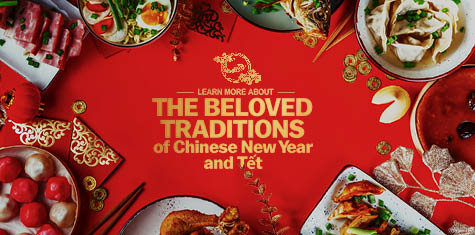
January 23, 2025 • News and Promotions~MoneyGram Promotions

Chinese New Year and Vietnamese New Year, known as Tết, are observed by millions in their respective countries and around the globe.
Both celebrations share many similarities, like family elders sharing red envelopes filled with money for children, colorful and widespread flower markets, and fireworks that fill the night sky with an array of beautiful patterns.
While both countries share these fond traditions, there are some key differences that make each New Year unique.
A key aspect of both Chinese New Year and Tết are feasts held with beloved friends and family. However, both countries boast large differences in their favorite dishes.
Tết is particularly known for bánh chưng, a square sticky rice cake wrapped in banana leaves, and thịt kho tàu, a traditional dish with pork belly and medium-boiled eggs in a broth made with coconut juice.
For Chinese New Year, a reunion dinner with family members takes place on New Year’s Eve. Specialty meats like Chinese sausage and seafood like lobster and abalone are usually reserved for this time of year. Other traditional foods include dumplings, sticky buns and sweet rice balls.
One of the largest differences between Chinese New Year and Tết is in their zodiacs. These reflect each respective countries’ cultures and philosophies, which rotate on 12-year cycles.
While the second animal on the Chinese calendar is the ox, the second on the Vietnamese calendar is the buffalo. Additionally, the fourth animal on the Chinese calendar is the rabbit, but the Vietnamese calendar recognizes the cat as their fourth animal.
Despite their differences, the ox and buffalo have the same themes, reflecting hard work and patience. The same applies with the rabbit and cat, with the pair symbolizing good luck and cleverness.
A major theme of each country’s New Year festivities surrounds visiting family and close friends.
For the first day of Tết, younger families spend time with the husband’s family, while extended families come together for the reunion dinner for Chinese New Year.
Both countries have the same traditions on the second day by visiting with the wife’s family and friends. On the third day, however, it is considered unlucky to have guests or to visit others for Chinese New Year. But for Tết, people visit and show respect to their teachers.
If distance separates you from your loved ones this New Year, MoneyGram is here to help you send prosperity and best wishes from around the globe.
With just a tap, you can send a fast and reliable money transfer in the MoneyGram® app, 24/7. Send directly to convenient receive methods like bank accounts, debit cards, mobile wallets and for cash pickup at a MoneyGram location near your friends and family.
Transfer money with just a few taps or clicks today.